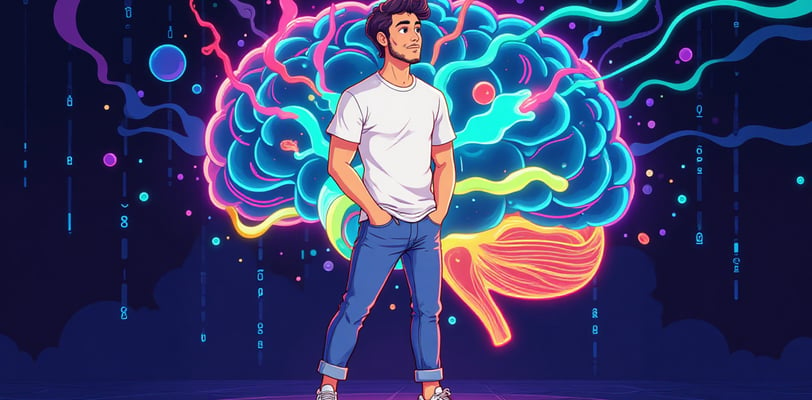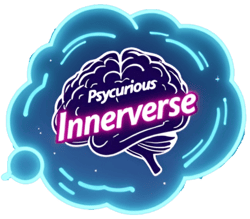Your Brain’s Greatest Lie: How Understanding Perception Changes Everything
What if everything you perceive isn’t as real as it seems? Our brains edit reality, filtering information to help us survive—but at the cost of accuracy. From cognitive biases to the limits of our senses, this article uncovers how your brain shapes your world and what lies beyond the illusions. Dive in to discover tools and practices to challenge these perceptions and unlock deeper truths about yourself and the universe.
1/17/20256 min read


Your Brain’s Greatest Lie: How Understanding Perception Changes Everything
Table of Contents
Introduction: A Constructed Reality
The Grand Illusion of Perception
Cognitive Biases: Mental Shortcuts That Shape Our World
Beyond the Visible Spectrum: The Reality We Don’t See
Evolution’s Role: Why Your Brain Chooses Efficiency Over Accuracy
Breaking Free from the Illusion: Mindfulness & Modern Technology
Conclusion: Embracing the Complexity of Our Minds
1. Introduction: A Constructed Reality
Imagine strolling through a lush forest, vibrant colors dancing before your eyes. The sunlight filtering through emerald leaves, the sharp detail of bark on towering trunks—everything looks so real. Yet, modern neuroscience reveals that much of what you perceive is your brain’s “best guess” of the world. It’s as if you’re living in a meticulously rendered simulation, painstakingly designed by your own mind. This isn’t a glitch in the matrix, but rather an ingenious system shaped by evolution.
The concept that your brain “lies” to you might sound unsettling, even conspiratorial, but it’s a fundamentally important insight into human cognition and survival. By recognizing that your perception of reality is meticulously constructed, you can begin to question assumptions, challenge biases, and tap into more profound ways of understanding yourself and the cosmos. This article expands on the key ideas presented in our video titled “Your Brain’s Greatest Lie: This Changes Everything,” offering deeper explanations, research references, and practical takeaways.
2. The Grand Illusion of Perception
One of the simplest demonstrations of your brain’s active role in constructing reality is the case of optical illusions. Perhaps you’ve seen a rotating dancer that appears to change direction or a checkerboard shadow illusion where squares of identical shade look drastically different. In each of these cases, your visual system is making inferences based on context, lighting, and your past experiences—an approach documented in depth by Dr. Richard L. Gregory in his work on visual perception.
Even something as basic as color perception is more subjective than you might realize. While you see an object as “yellow,” that color is merely your brain’s interpretation of wavelengths reflecting off the object. In reality, “yellow” doesn’t objectively exist outside your neural processes. You perceive yellow because your brain converts particular wavelengths of light into an experience of color. This phenomenon is famously explained by neuroscientist Beau Lotto in his research on illusions and color perception.
Key Insight: Your mind is an active co-creator of what you see, layering interpretations on top of raw sensory data.
3. Cognitive Biases: Mental Shortcuts That Shape Our World
Vision isn’t the only realm where your brain takes shortcuts. Your thought processes are also subject to quick “rules of thumb,” or cognitive biases, which help you make snap judgments. While these biases allow for faster decision-making, they can also distort your understanding of the world.
Confirmation Bias: We tend to seek out evidence that validates our existing beliefs, ignoring information that contradicts them. As psychologist Peter Wason noted, this bias can lead to “tunnel vision,” where we only see what we want to see.
Anchoring: The first piece of information we encounter tends to set our mental baseline, skewing subsequent decisions. Salespeople often use this effect by presenting a very high “initial price” so that a lower subsequent offer seems like a bargain.
Availability Heuristic: We estimate the likelihood of events based on how easily examples come to mind. If you’ve recently heard about a plane crash, you might suddenly feel that air travel is highly dangerous, despite statistical data showing it’s far safer than driving.
These biases evolved because efficiency mattered more than absolute accuracy in ancestral environments. Modern tasks—like critically evaluating news or making financial decisions—reveal the limitations of these outdated shortcuts. By acknowledging cognitive biases, you can take steps to question your knee-jerk judgments and broaden your understanding.
4. Beyond the Visible Spectrum: The Reality We Don’t See
The range of the electromagnetic spectrum visible to humans is a minuscule slice of the broader continuum that includes radio waves, microwaves, infrared, ultraviolet, X-rays, and gamma rays. This severely restricts our direct sensory experiences. While bees detect ultraviolet patterns on flowers and snakes sense infrared heat signatures in prey, our sensory world is comparatively narrow.
Neuroscientist David Eagleman points out that the “umwelt”—the slice of reality an organism can perceive—is different for each species. What you interpret as the entire reality is merely one channel on a vast cosmic TV set. Such revelations encourage humility: if we can’t detect these hidden layers of reality, what else might we be missing?
5. Evolution’s Role: Why Your Brain Chooses Efficiency Over Accuracy
Your ancestors weren’t concerned with understanding quantum mechanics or ultraviolet light. Their primary tasks were to avoid predators, find food, and reproduce. As a result, the human brain is wired for “survival intelligence” rather than a complete, objective view of the world. Speed, not thoroughness, was the name of the game.
Imagine you’re a prehistoric human spotting stripes in tall grass. The faster you interpret them as a lurking tiger and flee, the better your chances of survival—even if it occasionally leads to a “false alarm.” This evolutionary compromise makes perfect sense in hazardous environments, even if it means we get duped by illusions or hold onto biases that don’t align with modern complexities.
Key Insight: Evolution optimized perception for quick and energy-efficient survival strategies, not for revealing every aspect of reality.
6. Breaking Free from the Illusion: Mindfulness & Modern Technology
Despite these built-in limitations, you’re not doomed to remain confined by your evolutionary wiring. Mindfulness—whether through meditation, reflective journaling, or simply pausing to question your immediate perceptions—helps you spot when your biases or mental shortcuts might be leading you astray. By staying mentally present, you can cultivate a more deliberate way of seeing and thinking.
Technological advances also offer hope for transcending our limited senses. Telescopes and microscopes allow us to peer into cosmic and microscopic realms, revealing worlds that would otherwise remain invisible. Augmented and virtual reality tools can overlay new data—like thermal imaging or electromagnetic field visualizations—onto our everyday environments. Through these breakthroughs, we can “pull back the curtain” of our narrow sensory perception, unveiling layers of existence that were once purely theoretical.
Recommended Reading: The Extended Mind by Annie Murphy Paul, which explores how external tools can broaden our cognitive capacities beyond biological constraints.
7. Conclusion: Embracing the Complexity of Our Minds
Your brain’s “greatest lie”—its incomplete and often biased portrayal of reality—might seem unsettling at first. Yet, recognizing this lie is also a gateway to deeper wisdom and personal growth. By seeing the blind spots in your perception, you gain the power to ask better questions, challenge automatic assumptions, and purposefully extend your senses through technology and curiosity.
In a universe sprawling with untapped mysteries, illusions are not necessarily a flaw but rather a feature of an ingenious, adaptive system. When you understand that your mental image of the world is shaped by evolution, sensory limitations, and cognitive shortcuts, you become more informed and open to the possibilities of what could be. You also cultivate a humbling awareness: for all our intellectual achievements, there’s still so much we don’t perceive and can’t directly experience.
Practical Takeaways
Question Immediate Perceptions: Whether it’s a color you assume is universal or a snap judgment about another person, pause and ask, “Could my brain be jumping to conclusions?”
Be Aware of Cognitive Biases: Keep a short list of common biases (confirmation, anchoring, availability) on hand. Recognize when they might be influencing your decisions.
Practice Mindfulness: Activities like meditation or mindful breathing can slow down your reactive mind, revealing the hidden processes shaping your perception.
Leverage Technology: Use telescopes, microscopes, and even augmented reality apps to explore realms beyond your biological senses.
Stay Curious: The more you learn about different sciences, cultures, and points of view, the more you challenge your brain to expand beyond familiar interpretations.
Further Resources
David Eagleman’s “The Brain: The Story of You”: Provides an accessible look at how our senses and perceptions shape reality.
Annie Murphy Paul’s “The Extended Mind”: Explores how external tools and environments can enhance cognitive capabilities.
Dr. Richard L. Gregory’s Research on Visual Perception: Offers in-depth discussions on how illusions highlight the predictive nature of the brain.
Liked This Article?
Share it with friends who might be intrigued by the concept of a constructed reality.
Comment with your own experiences of optical illusions or surprising biases you’ve uncovered.
Subscribe to our blog or channel to delve deeper into neuroscience, psychology, and the vast cosmos of the mind.
In the end, embracing the gaps in your perception is a form of intellectual freedom. Recognizing your brain’s illusions is the first step toward refining your view of the universe—and that shift in perspective can indeed change everything.
